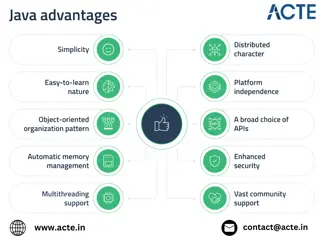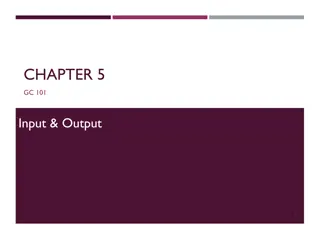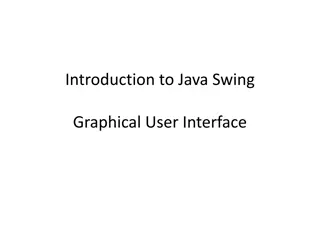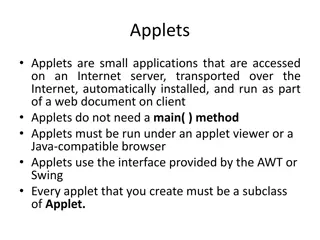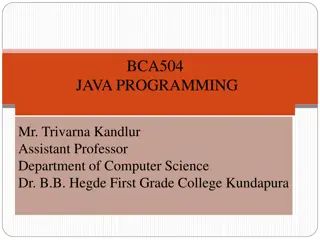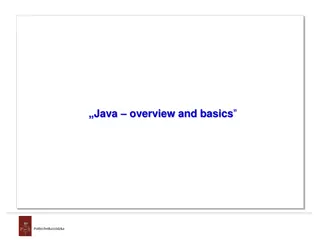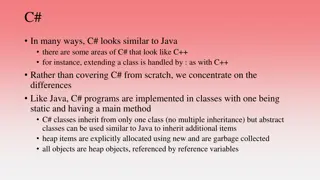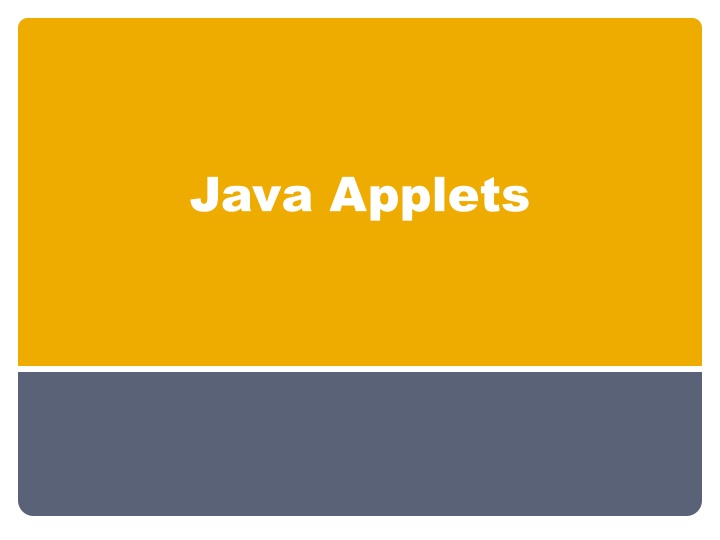
Creating Java Applets: A Beginner's Guide to Applet Development
Learn how to develop Java applets and integrate them into HTML documents. Explore the process of initializing, starting, and stopping applets, as well as customizing their output using the paint(Graphics g) method. Discover essential steps from building Java class files to setting up a basic HTML structure for applet execution.
Download Presentation

Please find below an Image/Link to download the presentation.
The content on the website is provided AS IS for your information and personal use only. It may not be sold, licensed, or shared on other websites without obtaining consent from the author. If you encounter any issues during the download, it is possible that the publisher has removed the file from their server.
You are allowed to download the files provided on this website for personal or commercial use, subject to the condition that they are used lawfully. All files are the property of their respective owners.
The content on the website is provided AS IS for your information and personal use only. It may not be sold, licensed, or shared on other websites without obtaining consent from the author.
E N D
Presentation Transcript
Applets The term Applet refers to a little application . In JAVA the applet is a java program that is embedded within a HTML document and Executed by web browser. Every applet is a subclass of java.applet.Applet ,So we should EXTEND the JApplet Class which is contained in javax.swing. To use swing components, use javax.swing.JApplet
Getting started Create a new java class file After that build the file the you will get tow files
Getting started Now use the previous code in to a regular HTML document <HTML> <HEAD> <TITLE> Welcome Applets </TITLE> </HEAD> <BODY> <OBJECT code="test.class" width="400" height="400" > </OBJECT> </BODY> </HTML>
Developing Applets Java applets do not need a main method. they can run in a web browser environment The applet have Init() Start() Stop() Paint( Graphics g)
init() called by the browser or applet viewer to inform this applet that it has been reloaded to the system We use init() to: Initialize variables Get data from user Place various GUI component.
start() & stop() Start() //called by the browser or applet viewer to inform this applet that it should start its execution Stop() //called by the browser or applet viewer to inform this applet that it should stop its execution
paint( Graphics g) is used to create the output . whenever you override this method the first java statement is super.paint(g); To draw a string we use drawString method Public abstract void drawstring(String str, int x, int y)
paint( Graphics g) To change the text font setFont(new Font( font name , font style , font_size) Using JDK guarantees the following fonts: Serif Sanserif Monospaced Dialog DialogInput Font style Font.PLAIN Font.BOLD Font.ITALIC To chang the text color setColor(Color.red) The available constant colors White, Black , blue, cyan, darkGray ,gray ,lightGray ,red, yellow,pink, orange, magenta ,green
JAVA application VS. applets Java applications and Applets share some common programming features although they differ in some aspects GUI Applets Is derived from class Jframe Is derived from class JApplet Have MAIN method Do not have main method instead It have init(), start(), stop(), paint(..) Uses the init() method to initialize the GUI component and data members don not use the because the HTML document do the job. Uses the class constructor to initialize the GUI component and data members Uses setSize(),setTitle(), setVisible() methode
converting JAVA application to applets Change the extends from JFrame to JApplets. Change the constructor to method init(). Remove method calls like setSize(),setTitle(), setVisible() . Remove the method main



